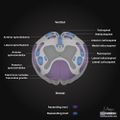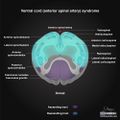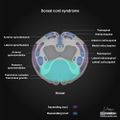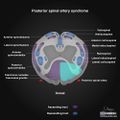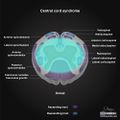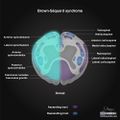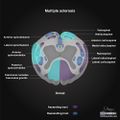◔
Incomplete Cord Syndromes: Difference between revisions
From WikiMSK
No edit summary |
|||
| Line 34: | Line 34: | ||
|Bilateral STT, CST, and autonomic center | |Bilateral STT, CST, and autonomic center | ||
|Ventral two thirds of cord | |Ventral two thirds of cord | ||
|Spinal cord infarction, trauma, multiple | |Spinal cord infarction, trauma, multiple sclerosis, disk herniation | ||
|Loss of pain and temperature sensations, weakness, bladder dysfunction | |Loss of pain and temperature sensations, weakness, bladder dysfunction | ||
|- | |- | ||
|Dorsal cord | |Dorsal cord | ||
|l Predominately dorsal columns; large lesions involve bilateral CST and | |l Predominately dorsal columns; large lesions involve bilateral CST and bilateral autonomic fibers (to variable degree) | ||
|Dorsal one-third of cord | |Dorsal one-third of cord | ||
|Vitamin B12 deficiency, multiple sclerosis, tabes dorsalis, AIDS* myelopathy, epidural metastases | |Vitamin B12 deficiency, multiple sclerosis, tabes dorsalis, AIDS* myelopathy, epidural metastases | ||
|Loss of proprioception and vibration sensations, sensory ataxia with positive Romberg sign, variable weakness, | |Loss of proprioception and vibration sensations, sensory ataxia with positive Romberg sign, variable weakness, bladder dysfunction | ||
|- | |- | ||
|Brown-Sequard | |Brown-Sequard | ||
| Line 47: | Line 47: | ||
|Hemicord lesion | |Hemicord lesion | ||
|Knife or bullet injury, multiple sclerosis, transdural migration of spinal cord | |Knife or bullet injury, multiple sclerosis, transdural migration of spinal cord | ||
|Ipsilateral weakness (UMN type) and loss of | |Ipsilateral weakness (UMN type) and loss of proprioception, contralateral loss of pain and temperature sensations, small band of LMN and sensory deficits at level of lesion | ||
|- | |- | ||
|[[Conus Medullaris Syndrome|Conus medullaris]] | |[[Conus Medullaris Syndrome|Conus medullaris]] | ||
| Line 53: | Line 53: | ||
|Spinal cord at level of T12 through L2 vertebrae | |Spinal cord at level of T12 through L2 vertebrae | ||
|Disk herniation, trauma, tumors | |Disk herniation, trauma, tumors | ||
|Bladder or rectal dysfunction, saddle anesthesia, | |Bladder or rectal dysfunction, saddle anesthesia, paraparesis (mixed UMN and LMN types) | ||
|- | |- | ||
|[[Cauda Equina Syndrome|Cauda equina]] | |[[Cauda Equina Syndrome|Cauda equina]] | ||
Revision as of 15:18, 23 April 2022
This article is a stub.
See kunam et al for an open access review.[1]
There are six patterns of deficit in the spinal cord:
- Ventral cord syndrome
- Central cord syndrome
- Dorsal cord syndrome
- Brown-Séquard syndrome
- Conus Medullaris Syndrome
- Cauda Equina Syndrome
Features
| Type | Tracts Involved | Lesion Location | Common Causes | Clinical Features |
|---|---|---|---|---|
| Central - small lesion | Anterior commissure where STT fibres cross | Near the central canal | Syringomyelia, intra-medullary tumour, hyperextension injury in cervical spondylosis | Suspected sensory deficit, classic cape distribution in lesion of cervical cord |
| Central - large lesion | Bilateral STT, CST, dorsal columns (variable), autonomic centre, and anterior horn cells | Large central lesion | Syringomyelia, intra-medullary tumour, hyperextension injury in cervical spondylosis | Disproportionate motor (UMN type) and sensory deficits: greater in upper extremities than in lower extremities, LMN deficit at level of lesion (anterior horn cells), variable loss of proprioception, autonomic dysfunction |
| Ventral cord | Bilateral STT, CST, and autonomic center | Ventral two thirds of cord | Spinal cord infarction, trauma, multiple sclerosis, disk herniation | Loss of pain and temperature sensations, weakness, bladder dysfunction |
| Dorsal cord | l Predominately dorsal columns; large lesions involve bilateral CST and bilateral autonomic fibers (to variable degree) | Dorsal one-third of cord | Vitamin B12 deficiency, multiple sclerosis, tabes dorsalis, AIDS* myelopathy, epidural metastases | Loss of proprioception and vibration sensations, sensory ataxia with positive Romberg sign, variable weakness, bladder dysfunction |
| Brown-Sequard | Unilateral STT, CST, and dorsal columns | Hemicord lesion | Knife or bullet injury, multiple sclerosis, transdural migration of spinal cord | Ipsilateral weakness (UMN type) and loss of proprioception, contralateral loss of pain and temperature sensations, small band of LMN and sensory deficits at level of lesion |
| Conus medullaris | Distal spinal cord containing lumbosacral segment | Spinal cord at level of T12 through L2 vertebrae | Disk herniation, trauma, tumors | Bladder or rectal dysfunction, saddle anesthesia, paraparesis (mixed UMN and LMN types) |
| Cauda equina | Lumbosacral nerve roots in spinal canal | Lesion compressing or involving nerve roots of cauda equina | Disk herniation, arachnoiditis, tumor, lumbar spine stenosis | Asymmetric multiradicular pain, leg weakness (purely LMN) and sensory loss, bladder dysfunction, areflexia |
Gallery
See Also
References
Literature Review
- Reviews from the last 7 years: review articles, free review articles, systematic reviews, meta-analyses, NCBI Bookshelf
- Articles from all years: PubMed search, Google Scholar search.
- TRIP Database: clinical publications about evidence-based medicine.
- Other Wikis: Radiopaedia, Wikipedia Search, Wikipedia I Feel Lucky, Orthobullets,
